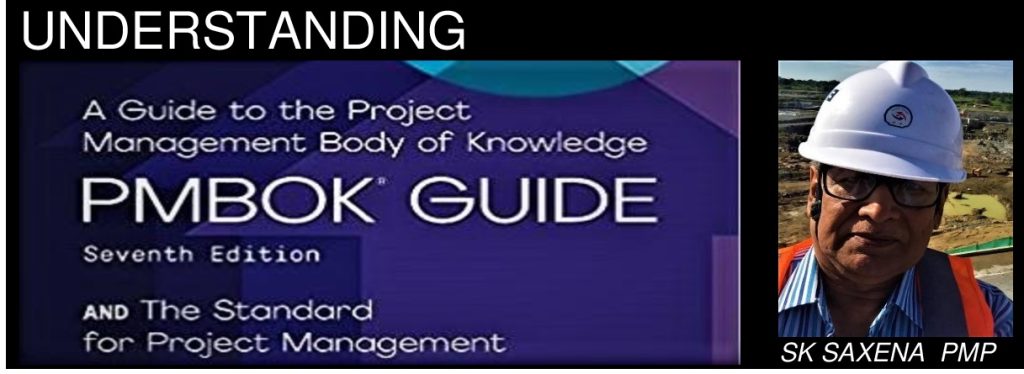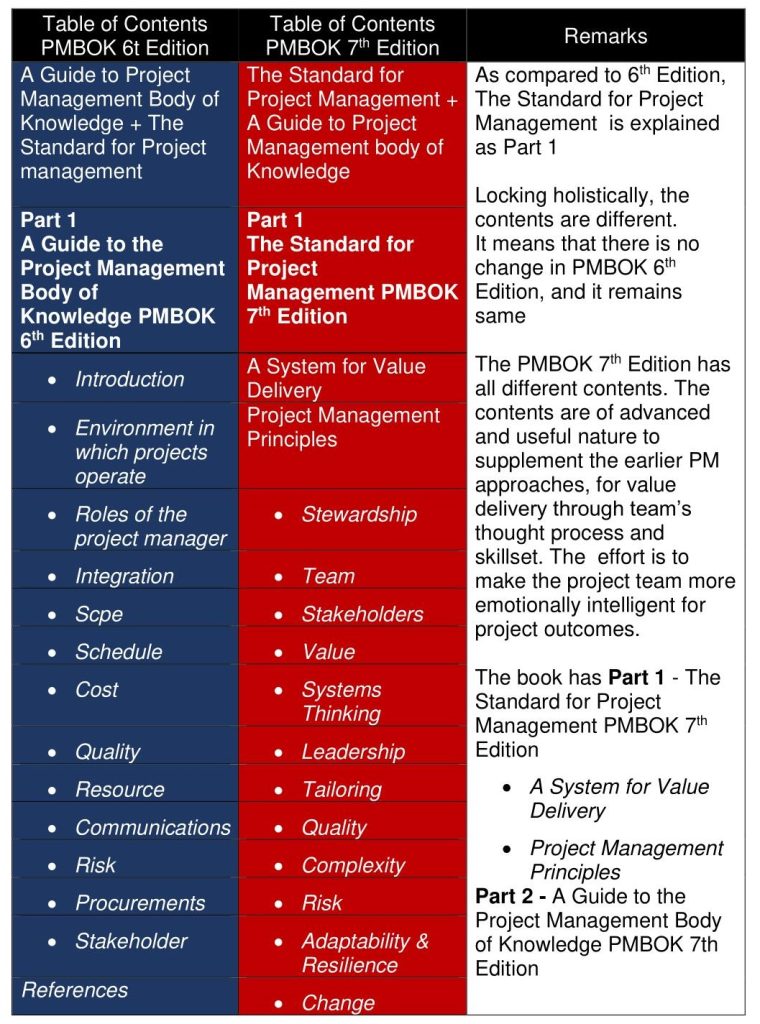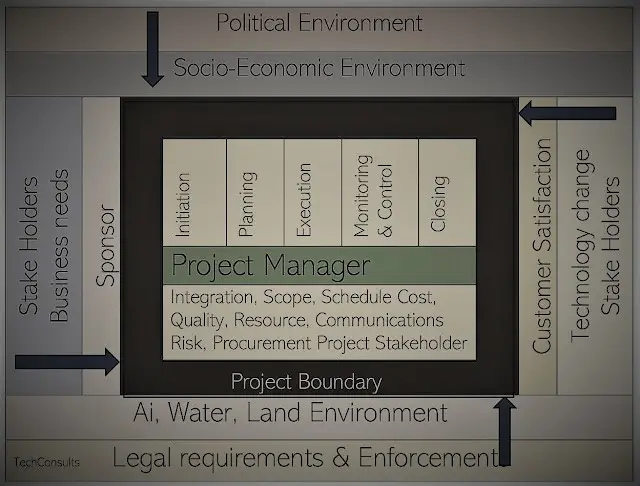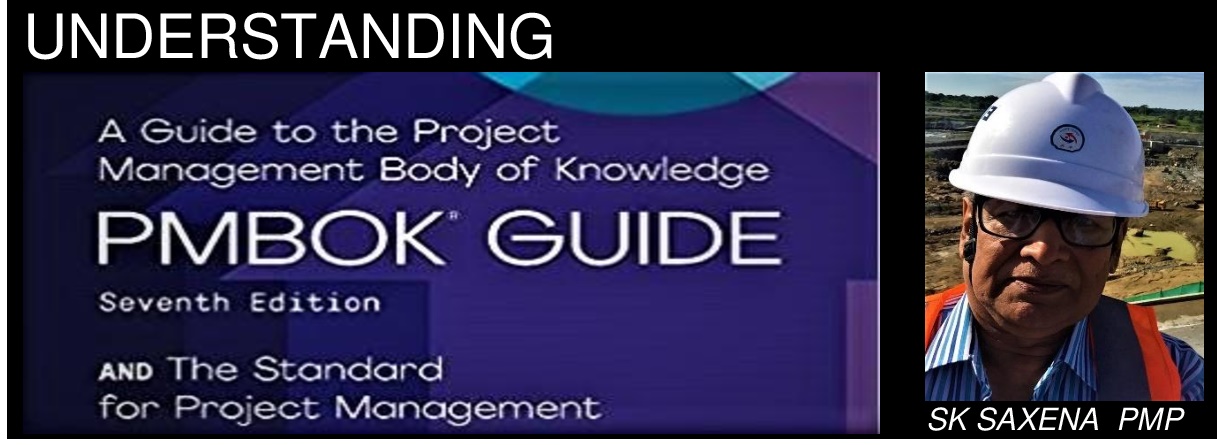(A guide to the Project Management Body of Knowledge)

The seventh edition provides a high-level principal-based guidance to the project-team ( without any changes to 6th edition guide) by inculcating the team behaviour, to manage the project, and have value added outcomes of the project. And this guidance is valid for all the project management approaches discussed in 6th edition of PMBOK Guide and other approaches
GENERAL
The ‘Standard for Project Management’ and ‘A Guide to the Project Management Body of Knowledge’ (PMBOK® GUIDE 7th Edition) is the latest edition (July 2021) from Project Management Instituter (PMI) – USA.
Please notice that earlier, each edition was an improvisation over the previous edition, but the 7th edition is different and is with no changes in the 6th edition. PMBOK Guide 7th Edition focuses on the thought process and behaviour of people involved in project delivery. The thought process and the behaviour are associated with Emotional Intelligence of the person, in addition to IQ. EI plays an important part in workplace operations. Overall, EI develops thought process and behaviour, which enhances workplace operations for valued outcomes.

There are organizations existing for centuries. They replace old technologies, skills and thought process ( collective thinking procedure) by managing and maintaining relevant changes, concepts (both art and science) to maintain their business
The Standard for Project Management has represented a process-based standard for efficient output. Alignment of the project management disciplines and functions around a processes-based practices can be documented, measured for performance, and could be improved for workplace operations and deliverables. This continued till PMBOK Guide 6th edition.
.
With advancement in project management disciplines and function to a greater extent, the alignment process with process-based standards is not convenient to follow ( the use of skills and thought process is limited) and as such the principle-based standard is generated to support improved project management disciplines and functions. This is mentioned in PMBOK Guide 7th Edition. July 2021
PMBOK® GUIDE 7th Edition
The 7th edition from PMI is the latest document in Guide series, issued in July 2021. The book is different in contents as it does not change the contents of PMBOK 6th Editions and the prevailing standards, but provide further guidance to the management process by suggesting follow up of principals and manage performance domains and other things.
PMBOK Guide 7th Edition focuses on the thought process and behaviour of people involved in project delivery. The thought process and the behaviour are associated with Emotional Intelligence of the person in addition to IQ. EI plays an important part in workplace operations. Overall, EI develops thought process and behaviour, which enhances workplace operations for valued outcomes.
Please refer to the following blog post on Emotional Intelligence:
Emotional Intelligence at Workplace R1 59
Emotional Intelligence at Workplace 1/2
Emotional Intelligence at Workplace 2/2
In IQ the cognitive abilities are assessed through vocabulary reading, comprehension and mathematical and reasoning skills and assessment is based on the scores assigned to assess intelligence abilities. And this practice exists today, also in higher educational competitions and is recommended in various private and government organization and in the international transfers of human resources. (It is based more on objectivity) EI/ EQ is individual’s ability to identify, understand, evaluate, control, and express emotions of self and others and groups. (It is based more on subjectivity) Together IQ and EQ provide success in all the fields.
IQ+EI/EQ=Makes one more successful.
PMBOK 6t and PMBO 7th Edition Compared


The Standard for Project Management and A Guide to the project Management Body of Knowledge (PMBOK® GUIDE 7th Edition) is divided in two parts.
PMBOK 7th Edition Part 1 – The Standard of Project Management
Standard – Something used as a measure , norm, or model to compare evaluation. There are standards to perform an action to give an outcome. The performer must understand the norms or rules carefully to align the operations and use his skill to maintain performances close to assigned rules.
The standard discusses the following two contents:
Project Management Principles
A System for Value Delivery
The systems view of project management.
The system approach is used to solve complexities in organisation. It is valid for use in portfolios, programs, and projects . A project is made up of various components. These components are not seen individually but holistically . Achievement of a component in project may be good for itself but may be injurious to another component. In system approach all components are viewed holistically so as to achieve the organisation goal with value addition. It is a disciplined way to solve complexities.
A system (project) may be considered consisting of sub systems (components). The subsystems complete a system. Each sub system must support the system. Also, to fulfil the objectives of systems, the subsystems are subjected to necessary changes to make it conducive for the system.
The Standard for Project Management and the PMBOK® Guide 7th edition, emphasize that projects should deliver outcomes (Outcome. A result or consequence of a process or project. Outcomes can include outputs and artifacts but have a broader intent by focusing on the benefits and value that the project was undertaken to deliver – PMI )as against outputs. Outputs are mostly quantitative; Outcomes are both qualitative and quantitative.
Value. The worth, importance, or usefulness of something. Different stakeholders perceive value in diverse ways. Customers can define value as the ability to use specific features or functions of a product. Organizations can focus on business value as determined with financial metrics, such as the benefits less the cost of achieving those benefits. Societal value can include the contribution to groups of people, communities, or the environment PMI
Value addition to project , portfolio, program, and operations is provides considering the following aspects:
Creating Value – Projects , portfolio, program, and operations must operate within a system, to produce value for organizations and their stakeholders.
Organizational Governance Systems – The aim of the governance in organization must be to have value added outcomes.
Functions Associated with Projects – Functions necessary for the completion of project for value delivery must be understood by the project team and need coordination with the key stakeholders.
The Project Environment – Not only the processes of project completion be conducted based on the internal environment but the external pressures on the project environment if not considered may affect the outcome of the project.
The PM Team should work within the boundary of project and pay close attention to the outside boundary of the project for the points mentioned underneath for project completion.
Political Environment
Financial Environment
Stakeholder Management
Business Needs of Sponsor
Project Initiation, Planning, Execution, Monitoring and Control and
Closing the project related to inside boundary of the project.
Integration of, Scope, Schedule, Cost, Quality, Resource, Communications, Risk, Procurement, and Project Stakeholder plan.
Client Satisfaction
Technology change
Artificial Intelligence
Water, Land Environment
Legal Necessities and Enforcement
The boundary of venture begins from project inception and finishes at project closure. That is, he starts, plans, executes, controls, and closes the task. (Inside Boundary)

Before this boundary is sponsor of the task or business need for which project / venture has begun. Additionally, past the inside boundary of this venture is the client or end user, for whose requirements fulfilment, the project is taken up.
As such PM is answerable for finishing of the project to the sponsor and the end user.
He should know about inside environment of the project and the external environment of the project and should be equipped for experiencing the pressing factors from the inside and outside, for project execution.
Project Management Institute is a pioneer organization in giving PMP accreditation, worldwide and is must for project manager who need to dominate in project execution field— www.pmi.org
Product Management Thought process identifies the ways portfolios, programs, projects, and products relate.
The Standard for Project Management PMBOK 7th Edition suggest 12 principles / rules to follow in project management practices. The rules are for the key stake holders to follow specially, so that they have productive behaviour and skill development generation to carry forward project operation to deliver valued outcome to end users.
The twelve-management principle are listed here. These are as given in BMBOK Guide 7th. (The reference of para given in bracket is the para of Part 1 of the book)
- Stewardship – Be a diligent, respectful, and caring steward (Section 3.1).
- Team – Create a collaborative project team environment (Section 3.2).
- Stakeholders – Effectively engage with stakeholders (Section 3.3).
- Value – Focus on value (Section 3.4).
- System Thinking – Recognize, evaluate, and respond to system interactions (Section 3.5).
- Leadership – Demonstrate leadership behaviors (Section 3.6).
- – Tailor based on context (Section 3.7).
- Quality – Build quality into processes and deliverables (Section 3.8).
- Complexity – Navigate complexity (Section 3.9).
- Risks – Optimize risk responses (Section 3.10).
- Adaptability – Embrace adaptability and resiliency (Section 3.11).
- Change – Enable change to achieve the envisioned future state (Section 3.12)
The ‘Code of Ethics and Professional Conduct’ of Project Management Institute (PMI) for Project Manager is a well-designed document for creating awareness in community. The topics suggested on
Fairness,
Respect,
Honesty and
Responsibility,
If applied in the form of Aspirational Standards as well Mandatory Standards sincerely will help in trust building, better performance, and better reputation for organizations.
TechConsults Professional and Social responsibility
Understanding Workplace Operations
Part 2 – A Guide to the Project Management Body of Knowledge
(PMBOK® GUIDE 7th Edition)
Domain – In general, a domain is an area of control or a sphere of knowledge. In project management there are several areas which are gone through to complete the project.
A GUIDE TO THE PROJECT MANAGEMENT BODY OF KNOWLEDGE (PMBOK® GUIDE) the PMBOK 7th edition, suggests eight such domains.
Stakeholders
Team
Development Approach & Life cycle
Planning
Project Work
Delivery
Measurement
Uncertainty

Tailoring
Tailor, in project management, is the act of choosing the process, related inputs and outputs of the project carefully to determine the subset of the processes to be included in the management approach of the project.
A project is always unique. No two projects are similar. The project management processes suggested in PMBOK guide 6th edition, specially covers all processes required for proper project management. However due to uniqueness of the projects , all processes, inputs, tools, and techniques etc. shall also be unique depending upon the nature of the project. As such it becomes necessary for the project team to orient the project activities by tailoring the suggested processes in PMBOK guide
This edition further expands / explains Tailoring in the PMBOK® Guide 7th edition.
Models, Methods, and Artifacts
The new section on Models (A model is an informative representation of an object, person, or system. Models can be divided into physical models and abstract models ), Methods (a particular procedure for accomplishing or approaching something, especially a systematic or established one.), and Artifacts (something observed in a scientific investigation or experiment that is not naturally present but occurs because of the preparative or investigative procedure. ) provides a high-level grouping of models, methods, and artifacts that support project management. This section maintains linkages to tools, techniques, and outputs from previous editions that support project management without prescribing when, how, or which tools teams should use.
PMIstandards+TM Digital Content Platform
There exists a relationship between the two parts, THE STANDARD FOR PROJECT MANAGEMENT and A GUIDE TO THE PROJECT MANAGEMENT BODY OF KNOWLEDGE (PMBOK® GUIDE) Seventh Edition. The relationship is further elaborated on the separate platform ( not in the book under reference) known as ‘PMIstandards+TM Digital Content Platform’.
The creation of PMIstandards + ™ in the PMBOK® Guide’s history, is an interactive, dynamic ‘digital platform’ that incorporates and explains current, emerging, and future practices, methods, artifacts, and other useful information for the project stakeholders. The contents shall be dynamic in nature on the time scale.
The book provides a platform so that the contents of all earlier approaches and the contents of this 7th edition book can be used electronically. With a provision of further addition of more useful PMI outputs and approaches of project management, this platform is useful in project management.
As per PMI, this platform L
- Links to the PMBOK® Guide via the Models, Methods, and Artifacts section while further expanding on that content.
- Incorporates content from all PMI standards as well as content developed specifically for the platform.
- Content reflects “how to…” in actual practice, including emerging practices.
At present platform contents are
- PMBOK® Guide – Seventh Edition
- PMBOK® Guide – Sixth Edition
- Agile Practice Guide
- PMI Guide to Business Analysis
- Practice Standard for Work Breakdown Structures
- And others
Summary
PMBOK® GUIDE 7th Edition – The Standard for Project Management and A Guide to the Project Management Body of Knowledge, is published from PMI in July 2021 and is the latest edition in PMBOK series. This guide has not changed contents of PMBOK 6th Edition. The major change is that PMBOK 7th edition , suggested is a principle-based approach in place of process-based approach / guidance. The guide suggests for
Value based outcomes in project delivery
Use of principles to guide the behaviour of the team project. – 12 Principals
The use of guided behaviour to manage project domains – 8 Domains
As such the book suggest a top-level tool to manage project work by improved behaviour of the team for valued outcomes
The PMBOK 7th Edition has all different contents. The contents are of advanced and useful nature to supplement the earlier PM approaches, for value delivery through team’s thought process and skillset. The effort is to make the project team more emotionally intelligent for project outcomes.

